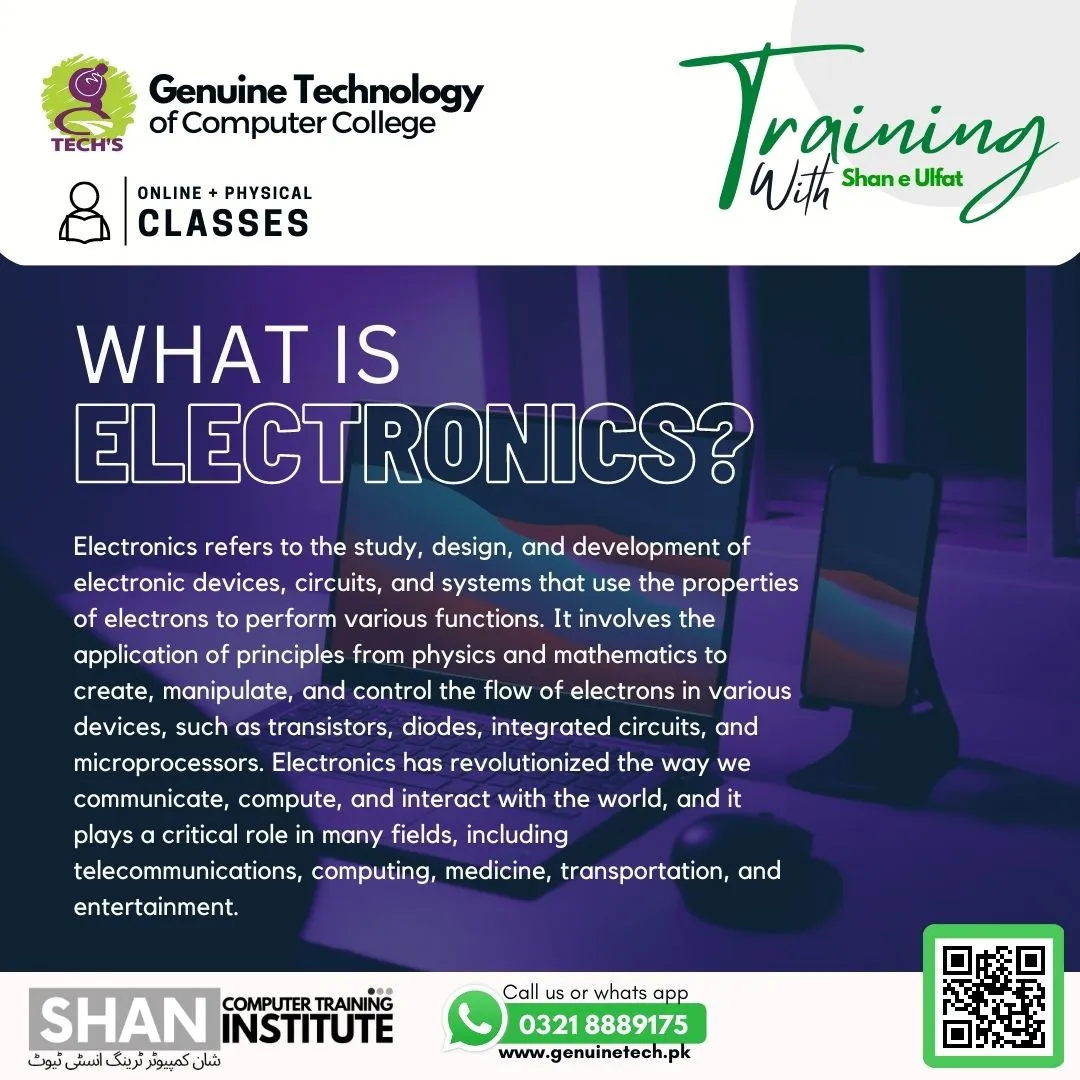What is Electronics?
What is electronics and example? shan
An introduction to Electronics
Electronics, a dynamic field at the intersection of physics and engineering, is dedicated to the study and application of electrical circuits and systems. At its core, electronics deals with the behavior and manipulation of electrons to control the flow of electrical currents. This discipline encompasses a vast array of components, including resistors, capacitors, transistors, and integrated circuits, all working together to process, transmit, and store information.
From the fundamental principles of Ohm's Law to the intricate design of microprocessors, electronics plays a pivotal role in powering the devices that define our modern world. Its applications are diverse, ranging from the circuits embedded in everyday household gadgets to the complex systems driving telecommunications, medical equipment, and space exploration. As technology continues to advance, the study and mastery of electronics remain crucial for innovators shaping the future of interconnected and intelligent systems.
Basic Electronics Concepts
Basic electronics concepts form the foundation of understanding how electronic systems function. At its core, electronics involves the manipulation and control of electrical currents. Voltage, current, and resistance, as described by Ohm's Law, are fundamental concepts guiding the behavior of electrical circuits. Components like resistors, capacitors, and inductors influence the flow and storage of electrical energy, while semiconductors, such as transistors, serve as essential building blocks for electronic devices.
The distinction between analog and digital signals is another key concept, influencing how information is processed and transmitted. Moreover, the concept of circuits, both series and parallel, plays a crucial role in designing and analyzing electronic systems. These foundational principles provide the groundwork for delving into more advanced topics, making a solid understanding of basic electronics essential for anyone venturing into the realm of electronic engineering and technology.
Understanding AC/DC Power Supply
Understanding AC/DC power supply is integral to comprehending the diverse ways electricity is delivered to power electronic devices. Alternating Current (AC) and Direct Current (DC) represent the two primary forms of electrical power. AC, characterized by its periodic change in direction, is the type of electricity supplied by most utility grids. It is well-suited for long-distance transmission. In contrast, DC maintains a constant flow of electricity in a single direction and is often associated with batteries and electronic devices.
Power supplies, therefore, play a crucial role in converting between these two forms to match the requirements of specific applications. Rectification, typically achieved through diodes, transforms AC to DC, and vice versa through inversion. This interplay between AC and DC power supplies is foundational in the functioning of a myriad of electronic devices, ensuring they receive the appropriate and efficient electrical energy needed for operation.
What are the 4 types of electronics?
Electronics can be broadly categorized into four main types based on their applications and functionalities. Consumer electronics encompass devices designed for everyday use, such as smartphones, laptops, and televisions. These are the gadgets that have become integral parts of our daily lives. Industrial electronics focus on applications within manufacturing and industrial settings, including automation systems, control panels, and robotics. Communication electronics involve the transmission and reception of information, covering technologies like radio, television, and telecommunications equipment. Finally, automotive electronics pertain to the electronic systems embedded in vehicles, ranging from engine control units to advanced infotainment systems. Each of these types represents a specialized branch of electronics, contributing to the diverse and interconnected landscape of electronic devices that shape our modern world.
Series and Parallel Circuits
Series and parallel circuits are fundamental configurations in electronics, influencing the flow of electrical current within a circuit. In a series circuit, components are connected end-to-end, forming a single pathway for the current to traverse. In a series circuit, the overall resistance is the cumulative sum of the individual resistances. Conversely, in a parallel circuit, components are arranged with multiple pathways for the current, each having the same voltage.
This arrangement results in an overall lower resistance compared to individual resistances. Series circuits find applications in situations where uniform current flow is essential, such as string lights, whereas parallel circuits are common in household wiring and complex electronic systems, ensuring that if one component fails, others continue to operate independently. Understanding and manipulating these circuit configurations are fundamental skills for electronic engineers, allowing them to design systems with specific performance characteristics and reliability.
Resistors Capacitors and Inductors
Resistors, capacitors, and inductors are fundamental electronic components that play distinct roles in shaping the behavior of electrical circuits. Resistors, characterized by their ability to impede the flow of electric current, are crucial for controlling the intensity of the current within a circuit. Capacitors, on the other hand, store and release electrical energy in the form of an electric field. They are essential for smoothing voltage fluctuations and timing applications.
Inductors, possessing the property of inducing a magnetic field when current flows through them, resist changes in the flow of current and are often used in applications such as transformers and inductive loads. Together, these components form the building blocks of electronic circuits, allowing engineers to design systems with precise control over current, voltage, and timing, thereby enabling the creation of a wide array of electronic devices and technologies.
Difference between Diode and Transistor
The diode and transistor are two essential semiconductor devices, each serving distinct functions in electronic circuits. A diode is a two-terminal component that allows current to flow in one direction only, acting as a one-way valve for electrical current. Its primary functions include rectification in power supplies and signal demodulation in communication circuits. In contrast, a transistor is a three-terminal device that amplifies or switches electronic signals.
Comprising the emitter, base, and collector terminals, transistors can regulate the flow of current between the collector and emitter based on a small input current at the base. This makes transistors pivotal in applications such as amplification in audio systems and digital switching in computers. While both diodes and transistors are integral to modern electronics, the key distinction lies in their functions: diodes control the direction of current flow, and transistors regulate and amplify electronic signals.
What is battery and switch?
A battery serves as a portable energy storage device, transforming chemical energy into electrical energy. Comprised of one or more electrochemical cells, batteries supply a steady voltage to power a variety of electronic devices, from small household gadgets to electric vehicles. The chemical reactions within the battery generate a potential difference between its terminals, creating an electric current when
connected to a circuit. Batteries come in various types, such as alkaline, lithium-ion, and lead-acid, each with specific characteristics suited to different applications.
On the other hand, a switch is a fundamental electronic component that controls the flow of electricity in a circuit. Acting as a binary device, a switch can either open or close a circuit, interrupting or allowing the flow of current, respectively. This on-off functionality is essential for controlling the operation of electronic devices, enabling users to easily manage the power supply to various components. Switches are found in numerous forms, from simple toggle switches to more complex digital switches, contributing to their widespread use in a multitude of electrical and electronic systems. In summary, while a battery stores and provides electrical energy, a switch governs the flow of this energy within a circuit.
What is the career scope of electronics?
The career scope of electronics is vast and continually expanding, offering diverse opportunities for professionals across various industries. With the relentless evolution of technology, electronic engineers find themselves at the forefront of innovation. They contribute to the design and development of cutting-edge electronic devices, telecommunications systems, and renewable energy technologies. Careers in electronics extend to areas such as embedded systems, robotics, and automation, where engineers play a pivotal role in creating smart and efficient systems. Genuine Tech provides basic electronic training in Lahore Pakistan.
Additionally, the growth of the Internet of Things (IoT) has opened up new avenues for electronics professionals, as connected devices become integral to daily life. The automotive industry also relies heavily on electronic innovations, with the development of electric vehicles and advanced driver-assistance systems. In the realm of healthcare, electronics engineers contribute to the design of medical devices and diagnostic equipment. As technology continues to advance, the career scope of electronics remains promising, providing professionals with opportunities to shape the future through innovation and technological breakthroughs.
What is the highest salary in electronics?
Determining the highest salary in the field of electronics involves various factors such as specialization, experience, geographic location, and the specific industry in which an individual works. Electronics professionals, ranging from engineers to researchers and executives, can command substantial salaries based on their expertise. For example, semiconductor engineers, involved in the design and development of integrated circuits, often earn high salaries due to the specialized nature of their work. Similarly, electronics professionals working in emerging technologies like artificial intelligence, robotics, and automation may see increased earning potential. Executive roles in electronics corporations can also lead to lucrative compensation packages. Ultimately, the highest salary in electronics is subjective and contingent on individual achievements, expertise, and the evolving demands of the electronics industry.
You can get information about Electronics and develop your skill.


If you want to get further details and update about computer trainings course don't hesitate direct whatsApp chat, call or visit and follow Facebook page, Instagram and get more information LinkedIn accounts
